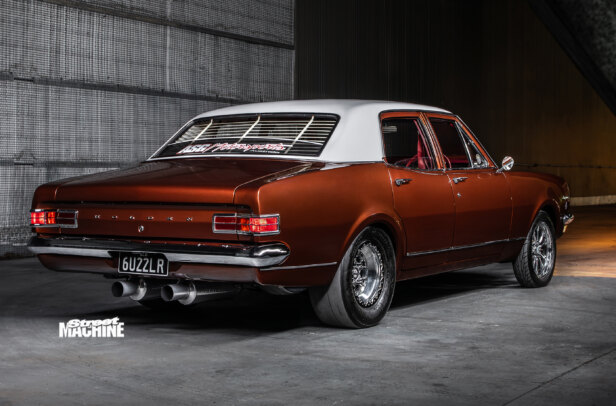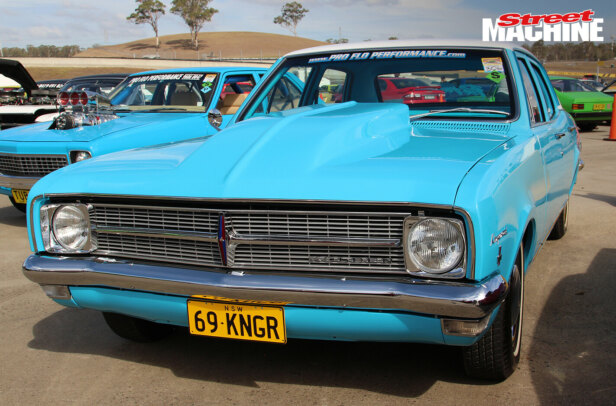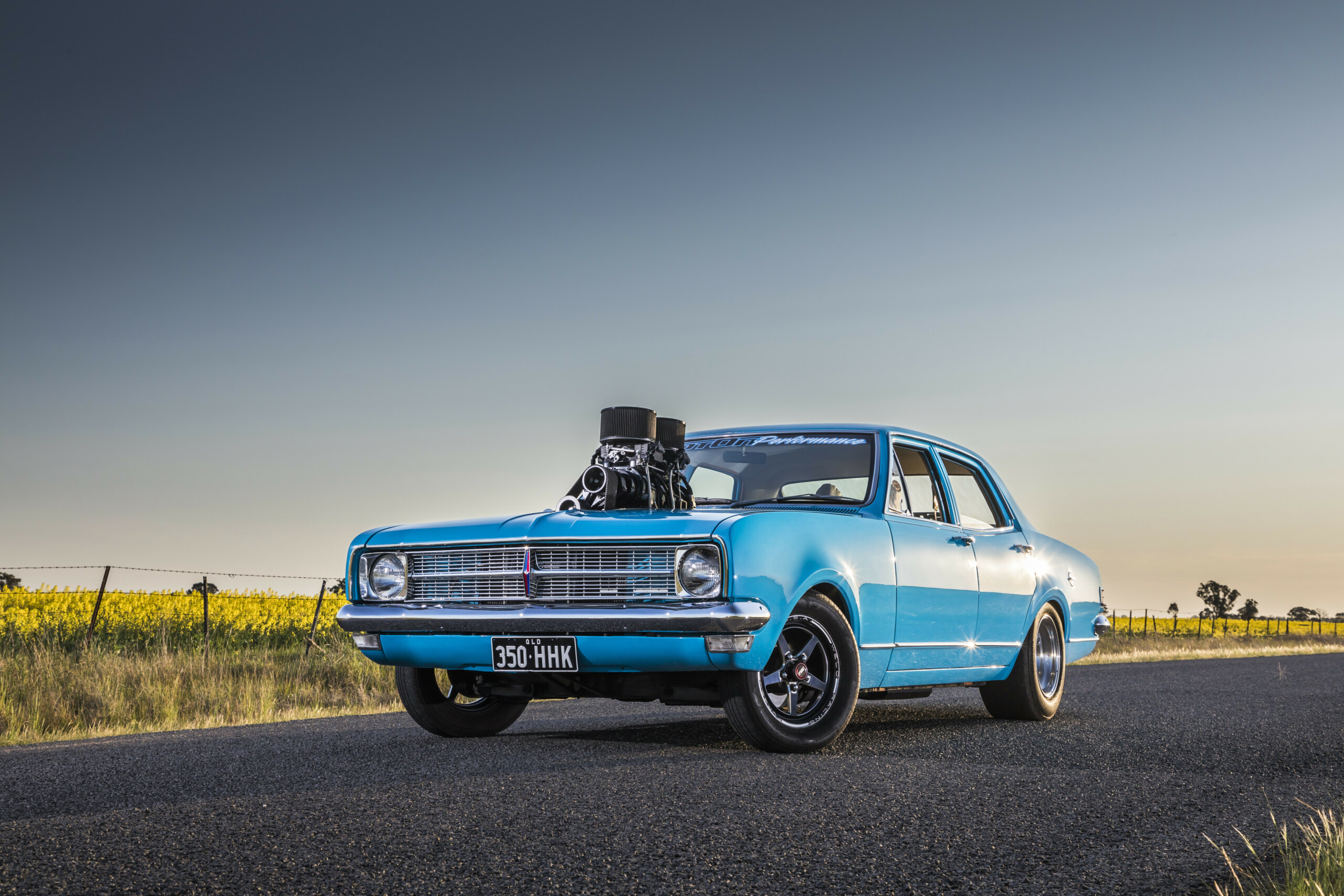This article on Jay’s HK Kingswood was originally published in issue no.7 of Street Machine’s LSX Tuner magazine, 2018
FEW cars deserve an uprated or updated V8 more than Holden’s HK-T-G series – something a lot of street machiners have realised over the years. While most were built with red sixes, plenty of K-T-Gs have rolled out with Chev or injected iron lion V8s over the past 50 years.
Queenslander Jay Jorgensen knew all that. As a P-plater in the 1990s, he used to perform a bit of naughty stuff with cars on the long, straight roads bordered by sugarcane around where he grew up, so he knew a bit about Chev V8s in old Holdens. But when he wanted to build a classy cruiser for his grown-up self, he went straight for the top shelf by using an LS3.
“Some people get the shits with LS engines,” Jay says with a chuckle. “But, man, the power and the efficiency and the bang for your buck is awesome!”
While the term ‘sleeper’ is overused these days, people don’t expect Jay’s HK to have the poke it does. “It’s all under the bonnet – there’s no scoop and it has a bonnet spear. It’s subtle-appearing, but there’s a bit of noise coming out of it!”
Firstly, Jay had to buy the car to put it in.
“I bought it around four years ago,” he explains of the HK Kingswood he picked up from a backyard just 30 kays from home. “It was in a bloke’s yard, pulled apart, and in rough but usable condition.”
The spooled 9in rear end is on the hit-list for an upgrade; the standard axles mean it’s on borrowed time, Jay reckons
It was the classic ‘unfinished project’, and Jay knew exactly what he wanted to do once he took it over.
“Pretty well from that point I was going to install an LS,” he says. “I love old-school stuff, but I also love technology.
“I did as much work as I could at home, stripping it and doing prep; it was pretty well back to bare metal. I looked for an old-school painter and got him to do the panelwork and paintjob, then I picked it up and re-fitted all the bits and pieces.”
As most street machiners will realise, that’s the short story, but Jay had a plan for a staggered build to suit his budget.
“I was to do the body and trim, then, when the finances had bounced back, install a fresh driveline,” he says. In the meantime, he spent more than two years cruising around in his now-copper-coloured Kingswood with the “old and oily” 179ci inline-six that was in the HK when he bought it.
Jay then purchased a 5.7-litre Gen III LS1 for the car but, in one of the few deviations from his well-arranged plan, changed spec to a Gen IV 6.2-litre LS3 bought from a wrecking yard. He says he now regrets buying it as a bare long motor, as he had to spend a stack of time chasing all the ancillaries. “I’ll never do that again!” he laments. “Lesson learned!”
The conversion was handled by Aaron Gregory from ASG Motorsports at Currumbin on the Gold Coast.
Jay installed a nine-inch rear axle, as well as the Gazzard Bros CalTracs-type suspension it rides on, before relocating the battery and installing a fuel cell so ASG could build an EFI-capable fuel system. With the red six yanked, Jay prepped the engine bay and had it painted in Pottsville before the Kingy was delivered to Aaron.
The engine bay is no-nonsense tidy, combining aesthetics and functionality. These LS motors always look a bit better with the coil packs relocated, and Jay’s are in the cabin, allowing him to run old school-looking rocker covers
As a precaution, Aaron opened the engine for a look and found the telltale signs of water damage. Jay and Aaron didn’t need too many more excuses to give things a hot-up, so the heads were decked and all the fasteners were replaced with ARP items. A VCM #14 cam and matched pushrods were installed along with Manley dual-valve springs to make the LS a little more grunty and revvy.
“It wasn’t going to be boosted, so we didn’t need hell hardware,” Jay says of the engine tweaks. “These things have terrific power potential in the standard heads, and I was working to a budget, too.”
Many LS conversions use a modified Commodore wiring harness and PCM, but Jay’s has a full Haltech Elite 2500 standalone ECU, with the set-up and tuning handled by Haltech specialists ASG. Jay admits his dual 3.5-inch exhaust pipes are too big, but they were a second-hand bargain buy.
“I know it is overkill, but they fitted, and saved me a lot of money.”
Behind the LS V8 there’s a reverse-pattern manualised TH350 ’box built by Precise Automatics, with a Dominator 4200rpm converter. Holding back the LS urge are Ford rear drums, HQ Holden vented front discs and an HQ stud pattern conversion (to make use of HQ wheels), with a Wilwood master cylinder. Depending on his mood, Jay swaps wheels – alloys for Saturday sillies, and whitewall tyres and hubcaps for Sunday coffees.
The interior mixes the original steering wheel, dash and door cards with new leather on the front bucket seats. Jay reckons it looks a little too grand, though, so will soon have it redone in more appropriate cheesy vinyl
“It drives beaut, and it had to be driveable,” Jay declares. “It had to be streetable and not too full-on, as I wanted to cruise it with my family. That said, it’s turned out pretty tough when I want it
to be.”
Steve and Ray at Pottsville Smash in northern NSW laid on the fresh colour after Jay did the basic prep work at home. Jay chose Bahama Copper Brown two-pack to replace the car’s original Grecian White. Although a nice modern, poppy colour, it’s a hue that looks era-correct and won’t fall out of fashion anytime soon
TIP IT IN
Although several companies offer LS-into-lots-of-things conversion kits, Aaron Gregory from ASG Motorsports advises that a conversion is not always as easy as some Facebook experts will tell you.
One hot tip Aaron offers is that some conversion parts don’t allow the engine or gearbox to be removed from the car separately; they must be installed or removed as a complete unit, which can add complexity to servicing the car. He fixed this on Jay’s Kingswood by modifying a lip on the firewall. He also made a new sump to allow plenty of space around the crossmember and steering linkage, while retaining a near-factory capacity of 5.8 litres.
Jay chose CAE four-into-one extractors to go with CAE engine mounts.
“These manifolds usually provide better top-end power than tri-Ys, especially with modified capacity and cammed engines,” says Aaron. “It’s tight around the steering box, but these ones fit without any problems. Rack ’n’ pinion steering conversions can help with engine transplants, but it’s not essential and, of course, it’s an extra cost.”
First-gen Kingswoods are a little tight in the trans tunnel, which is one reason why the smaller TH350 and TH400 three-speed autos are often used with these swaps.
“Even then, there’s a modification required for the reinforcing rib that follows the floor at the back [of the tunnel],” says Aaron, who leans towards TH350s and 400s in these situations for their strength and simplicity. “The Turbo 700 four-speed won’t sustain 500rwhp consistently, and the electronic ones need a standalone controller. Plus, they still don’t handle the power even when they’ve been rebuilt.”
While buying, installing and tuning a Haltech Elite 2500 ECU and loom kit isn’t a complete budget option, it negates the need to have a second-hand Holden loom cut down and the stock ECU re-flashed to run the donor car (which includes removing anti-theft modules). Aaron respects that many people wish to retain the Holden computer and wiring from a donor car, but when you tally up the full cost of the conversion, using brand-new hardware rather than paying for modifications to standard hardware can be surprisingly inexpensive.
Another tip Aaron has is to ensure the coolant line from the radiator to the LS throttlebody is retained. He sees lots of conversions that don’t use that line, and it’s not kind to LS heads. He also advises reinforcing old bodyshells that were originally engineered for one-fifth the power of a healthy modern V8.
“Any car that’s being rebuilt from the ground up with more power will benefit from stitch-welding to help prevent separation of rivets and spot welds,” he says.
JAY JORGENSEN
1969 HOLDEN HK KINGSWOOD SEDAN
PAINT
Bahama Copper Brown
ENGINE
Type: GM Gen IV LS3 V8
Capacity: 6.2L
ECU: Haltech Elite 2500
Heads: Standard LS3, decked
Camshaft: VCM #14
Conrods: Standard with ARP bolts
Fuel system: Fuel cell, Bosch 044 pump
Cooling: Three-core alloy radiator, SPAL 3000cfm electric fan
Exhaust: CAE 4-into-1 extractors, dual 3.5in exhaust
Ignition: Relocated coil packs
TRANSMISSION
Gearbox: TH350 manualised auto
Converter: Dominator 4200rpm
Diff: 9in, shortened, mini-spool, 3.89:1 gears
SUSPENSION & BRAKES
Front suspension: King coil-overs, Koni adjustable shocks
Rear suspension: Reset HK leaves with McDonald Bros CalTracs-style links, Koni adjustable shocks
Brakes: HQ vented discs (f), Ford drums (r) Master cylinder: Wilwood




Comments